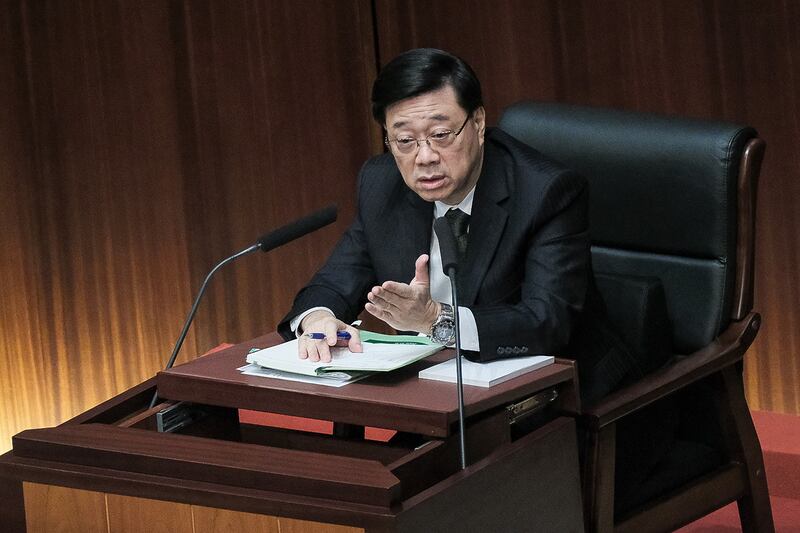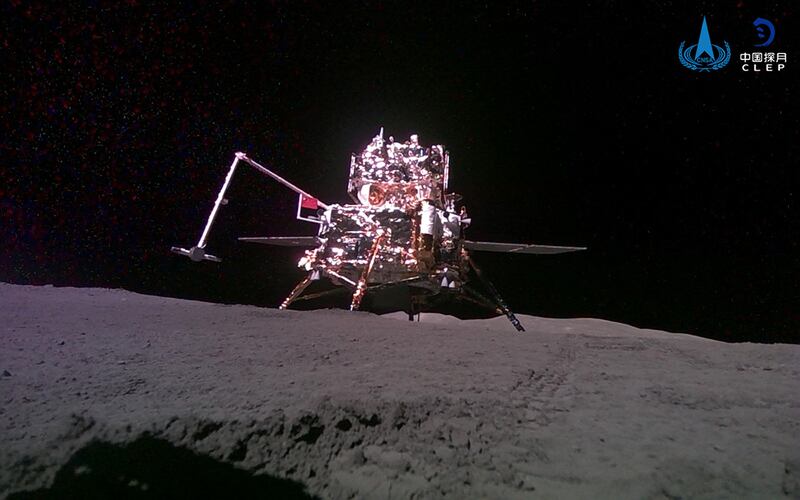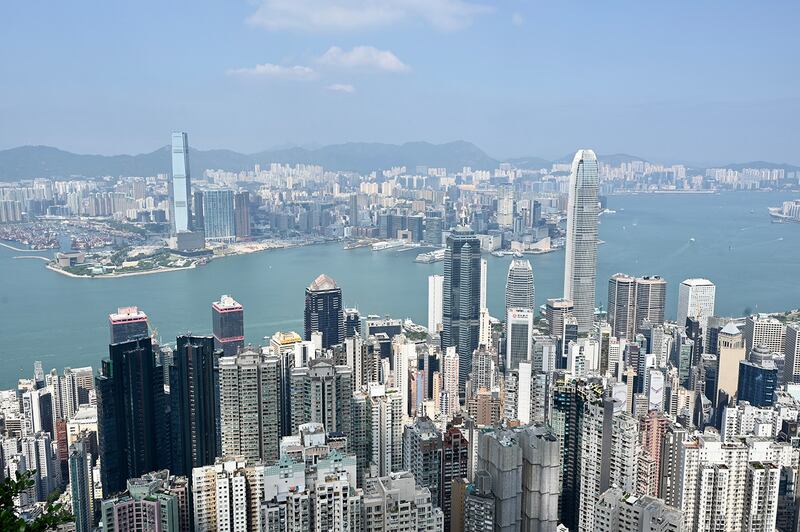The U.S. Treasury Department finalized an investment ban aimed at curbing China’s military-linked high-tech ambitions in artificial intelligence, advanced computer chips and quantum computing this week, prompting angry reactions in Beijing and Hong Kong on Tuesday.
New rules issued Monday bar U.S. businesses and citizens from investing in a slew of advanced technologies in “countries of concern,” and specifically list mainland China, Hong Kong and Macau among them.
“U.S. investments ... must not be used to help countries of concern develop their military, intelligence and cyber capabilities,” Paul Rosen, assistant Treasury secretary for investment security, told the Associated Press, warning that such investments also bring with them other benefits including managerial help and assistance finding top talent and tapping other sources of financing.
Violators can be hit with a fine could be as high as twice the value of the prohibited transaction or US$368,136, whichever is greater. The rules will be enforced by a newly created Office of Global Transactions, the agency reported.

China “strongly deplores and firmly opposes” the ban, foreign ministry spokesperson Lin Jian told a news briefing in Beijing, while Hong Kong Chief Executive John Lee said it would damage global supply chains, warning that “American politicians will suffer the consequences” of pursuing what he called their “political interests.”
Why has Hong Kong been named in the latest investment restrictions?
There is growing evidence that the ruling Chinese Communist Party is leveraging Hong Kong universities and private companies for research funding, expertise and links to global supply chains.
A low-orbit AI surveillance satellite jointly designed and developed by the Chinese University of Hong Kong that was successfully launched on Sept. 24, 2024, ostensibly for use in “disaster prevention.”
But experts say the technology used in such hardware, which can monitor the movements of people and vehicles to distances of less than one meter, can very easily be modified for military use.

The university’s Chinese partner in the project, state-owned Nationstar Aerospace, was named by national security expert Elsa Kania at a U.S.-China Economic and Security Review Commission hearing last year as an example of “military-civil fusion,” a key goal of Chinese President Xi Jinping’s military modernization program, which seeks to blur the line between military operations and the civilian economy in an all-out bid to modernize the People’s Liberation Army.
Are other Hong Kong universities involved in these plans?
At least four universities, including the Chinese University of Hong Kong named in the above example, are known to have worked on the development of remote-sensing satellite technology, which is also used in military reconnaissance.
Hong Kong‘s Polytechnic University has boasted of having “more than 30 years’ experience” in aerospace research, and has participated in Chinese space missions on many occasions, and was involved in the joint development of a “surface sampling execution device” for China’s Chang-e-6 lunar probe and in the 2021 Tianwen-1 Mars rover mission.
In September, it signed a cooperation agreement with Nationstar Aerospace, sanctioned by the United States in 2022 for allegedly trying to steal sensitive technology, to set up a remote sensing lab to “jointly conduct scientific research that contributes to national development.”
In August 2023, the Hong Kong University of Science and Technology collaborated with China’s Changguang Satellite Technology, another key player in Xi Jinping’s military-civil fusion strategy, in the successful launch of the first earth observation satellite, the Xiongbin-1.
Changguang Satellite Technology was sanctioned in June by the European Union for “supporting the Russian military-industrial complex” in the Ukraine war.
The University of Hong Kong’s space lab researchers also worked on the Lobster Eye dark matter detection satellite, launched in July 2020, alongside companies in the China Aerospace family of state-owned companies, which includes missile-maker China Aerospace Science and Industry Corp.
In 2021, lunar exploration third phase designer Hu Hao predicted “more collaboration between the Chinese mainland and Hong Kong in the country’s aerospace projects in the future,” state media reported, adding that the University of Hong Kong had a “competitive edge” in remote sensing technology.
“We certainly hope to work with competitive and strong institutions to research and design aerospace facilities and equipment,” Hu said.
What role do Hong Kong companies play in this process?
According to Shu Hsiao-huang, associate researcher of the Chinese military at Taiwan’s Institute for National Defense and Security Research, some Chinese state-owned conglomerates and universities have well-documented ties to the People’s Liberation Army, and are obvious targets for international sanctions, while private sector companies in Hong Kong are far more likely to be able to evade scrutiny.
“They’re taking the opportunity now to find some loopholes via universities and private companies, especially in the field of AI, which absolutely needs private innovation, investment and development,” Shu told RFA Cantonese in a recent interview. “State-owned enterprises are too easily targeted because they’re so big, so private enterprises are used to inject innovative power into state-owned companies.”
Hong Kong is also a great place to source supplies by setting up companies not perceived to have military links, with a straightforward company registration process that has seen a proliferation of shell companies in recent years.
“[China is] using Hong Kong’s advantages to set up companies just to help with sourcing, or that could then collaborate with universities in Hong Kong, for example, or with other private companies, as a way around this,” Shu said.
How much is Hong Kong spending on such projects?
Investment in national innovation and high-tech schemes became a policy priority after the government rewrote election rules to exclude opposition candidates from public office.
But precise breakdowns are hard to come by.
In 2020, the city’s government pumped HK$2 billion (US$257 million) into its Innovation and Technology Fund to fuel innovative start-ups in the Greater Bay Area that includes neighboring cities in mainland China, but has never published a detailed account of where the money goes.

In his October 2024 policy address, John Lee announced a HK$10 billion Innovation & Technology Industry-Oriented Fund “to guide more market capital to invest in specified emerging and future industries of strategic importance, including life and health technology and artificial intelligence.”
Officials at the city’s Innovation and Technology Bureau said they had funded 76,000 projects since the fund began on June 30, 1999 to the tune of around HK$45 billion (US$5.8 billion), but declined to provide a breakdown requested by RFA Cantonese.
The universities mentioned in this article declined to respond when asked for details of funding for their collaborations with military-linked Chinese enterprises.
Yet it seems there’s plenty of money around in the sector.
According to the National Bureau of Statistics, China invested more than 3.3 trillion yuan (US$462 billion) in research and development last year, a rise of 8.4% on the previous year. China’s nationwide R&D expenditure is currently second only to that of the United States.
China also saw the creation of more than 110,000 new aerospace companies last year, a rise of nearly 30% from the previous year, with the country launching hundreds of satellites in the past three years. That is likely to rise to more than 10,000 over the next decade.
Translated by Luisetta Mudie. Edited by Luisetta Mudie and Eugene Whong.
